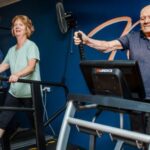What is Aerobic Fitness and How Can I Measure It?
The start of a new year can often feel like the start of a new chapter in our lives. It’s a chance to hit ‘reset’ and focus on making change in different areas of your life. As we enter another new year, you might have set yourself some goals – or resolutions – around fitness.
However, choosing to focus on fitness is much easier said than done, as there are many factors that come into play. If you’re ready to start a new fitness program, it helps to know the specifics around your current level of fitness, so that you can set realistic fitness goals, monitor your progress and maintain your motivation.
One such tool of measurement that will help you in achieving your fitness goals is your aerobic fitness. Throughout this article, we’ll be diving into the importance of aerobic fitness, explaining what it is and how it can be measured. We’ll also include some tips and strategies for improving your aerobic fitness, to help you achieve your fitness goals.
Whether you’re a seasoned athlete or are just starting to focus on getting back into shape, the tips we outline below will provide you with valuable information on how to enhance your aerobic fitness and improve your overall health and wellbeing.
What is Aerobic Fitness?
By definition, ‘aerobic’ means ‘with oxygen’. Aerobic fitness (also often referred to as cardio fitness) is a measure of how well your body can use oxygen to produce energy during physical activity. It refers to the efficiency of your heart, lungs, and blood vessels in delivering oxygen to your muscles and how well your muscles can use that oxygen to produce energy.
To put it simply, aerobic fitness is a measure of how well your body can sustain physical activity using oxygen.
Why is Aerobic Fitness Important?
Aerobic fitness is important for overall health and wellbeing. The fitter the person, the more efficiently the whole system (heart, lungs, blood vessels and cells) will work.
When your body is able to use oxygen efficiently, it helps to:
- Improve heart health: by strengthening the heart muscle, which in turn helps to pump blood more efficiently throughout the body.
- Aid in weight management: regular aerobic activity can help to burn calories and maintain a healthy weight.
- Boost energy levels: when your body is able to use oxygen efficiently, it helps to produce energy, which can lead to feeling more energized and less fatigued.
- Improve mood: aerobic activity can release endorphins, which are chemicals in the brain that can improve mood and reduce stress.
- Increase endurance and stamina: when your body is able to use oxygen efficiently, it can sustain physical activity for a longer period of time.
Conversely, poor fitness caused by physical inactivity is one of the major risk factors for:
- Cardiovascular disease, including high blood pressure, heart conditions, and stroke;
- Type 2 diabetes;
- Overweight and obesity;
- Osteoporosis;
- Some cancers, especially breast and colon cancer.
In short, aerobic fitness is important for maintaining a healthy heart, managing weight, and feeling good both physically and mentally.
How to Measure Aerobic Fitness?
Don’t forget a notepad and pen when measuring your aerobic fitness, so that you can record your scores!
Heart Rate Test
The simplest way to assess your aerobic fitness is by measuring your resting heart rate. This is your heart rate when you are completely relaxed – not when you’ve found a spare minute to sit down during the day!
For most adults, a healthy resting heart rate is between 60 – 100 beats per minute. To measure your heart rate, you can either:
- Check your pulse over your carotid artery (on your neck) by placing your index and middle fingers on the side of your neck, next to your windpipe.
- Check your pulse at your wrist, by placing two fingers between the bone and tendon over your radial artery, on the palm side of your wrist below the thumb.
Make sure you have a stopwatch or a watch that counts seconds handy!
When you feel your pulse, count the number of beats in 15 seconds. Then, multiply that number by 4 to get your heart rate per minute. For example, if you count 20 beats in 15 seconds, you would multiply 20 by 4, for a total of 80 beats per minute.
Target Heart Rate Zone
Another way to assess your aerobic fitness is to measure your heart rate’s response to exercise.
The target heart rate zone is an increase in your heart rate (of between 50% – 85% of your maximum effort).
One exercise that you can test your target heart rate zone is the Home Step Test. To conduct this test you will need:
- 30cm high bench or step
- Stopwatch
- Metronome or cadence app
Then, to complete the test you will need to follow the below steps:
- Step up and down onto the step or bench, one foot at a time, for three minutes.
- Try to maintain a steady four-beat cadence (96 bpm on the metronome). It can help to talk yourself through it; up up down down.
- When you’ve finished the test, count your heart rate.
- Use the final value to assess your performance against the table below.
It can be expected that with appropriate training, your results will improve (the lower your heart rate, the fitter you are).
Run or Jog Test
Another way to assess your aerobic fitness is to time yourself on a 2.4 kilometre run. The table below shows what is considered a good indicator of fitness.
Remember, a lower time generally indicates better aerobic fitness, while a higher time suggests a need for improvement!
Tips for Staying Fit
The results of your aerobic fitness assessment can help you set goals for staying active and improving fitness outcomes. According to the Australian Government Department of Health and Aging, adults aged between 18-64 years should accumulate 150 – 300 minutes of vigorous-intensity physical activity most days every week, while older adults aged 65+ should accumulate at least 30 minutes of moderate intensity physical activity on most days.
Moderate intensity aerobic activities include:
- Walking briskly
- Water aerobics
- Cycling on mostly flat ground
- Pushing a lawn mower
Vigorous intensity aerobic activities include:
- Running
- Swimming laps
- Fast cycling or cycling hills
- Playing basketball or soccer
- Playing tennis
Where to from here? – Monitoring your progress
It’s important that you keep track of your progress for improving your aerobic fitness. We recommend that you take the same measurements every six weeks when you begin a new exercise program.
Every time you complete your assessment, make sure you celebrate your progress and adjust your fitness goals accordingly. If you need further guidance, you can always share your results with your personal trainer or doctor.
Do you need help in assessing your aerobic fitness? Or, need an accountability partner to help get you started? Contact us today for more information on how we can work together and help you to achieve your fitness goals this year!










